Abstract
In the present work, highly multiplexed diagnostic KITs based on an Interferometric Optical Detection Method (IODM) were developed to evaluate six Coronavirus Disease 2019 (COVID-19)-related biomarkers. These biomarkers of COVID-19 were evaluated in 74 serum samples from severe, moderate, and mild patients with positive polymerase chain reaction (PCR), collected at the end of March 2020 in the Hospital Clínico San Carlos, in Madrid (Spain). The developed multiplexed diagnostic KITs were biofunctionalized to simultaneously measure different types of specific biomarkers involved in COVID-19. Thus, the serum samples were investigated by measuring the total specific Immunoglobulins (sIgT), specific Immunoglobulins G (sIgG), specific Immunoglobulins M (sIgM), specific Immunoglobulins A (sIgA), all of them against SARS-CoV-2, together with two biomarkers involved in inflammatory disorders, Ferritin (FER) and C Reactive Protein (CRP). To assess the results, a Multiple Linear Regression Model (MLRM) was carried out to study the influence of IgGs, IgMs, IgAs, FER, and CRP against the total sIgTs in these serum samples with a goodness of fit of 73.01% (Adjusted R-Squared).
1. Introduction
The Severe Acute Respiratory Syndrome Coronavirus 2 (SARS-CoV-2) is responsible for a worldwide pandemic causing millions of infected people and a significant number of deaths [1,2,3]. In Spain, the Coronavirus Disease 2019 (COVID-19) pandemic caused by SARS-CoV-2 started at the beginning of 2020, with Madrid (Spain) being one of the areas with a higher number of cases.
SARS-CoV-2 is a single-stranded RNA-enveloped virus whose genes S, E, M, and N encode structural proteins. Unlike other functional proteins of SARS-CoV-2, the S protein on the viral surface is responsible for virus entry into the host cells, is able to induce the host immune response, and is the main antigen of the virus to elicit neutralizing antibodies [1,4,5]. However, it must be considered that studies carried out in Singapore populations and by the Wuhan Union Hospital indicate that a percentage of 0.6 to 12% of patients with COVID-19 do not produce specific antibodies against SARS-CoV-2 [6,7], and a percentage of children are not affected by the virus, as reported in several works; for example, a study across 25 European countries showed 16% of asymptomatic cases to be in children [8,9,10].
In the study carried out at the University Hospital of La Paz (Madrid, Spain), the severity of the COVID-19 disease was evaluated on a sample of more than 2226 patients (this cohort of patients included patients hospitalized from 25 February to 19 April 2020), with a higher incidence in the elderly (the median age reported in the article was 61 years old). Global mortality was over 20% (460 of the 2226 patients died), with a higher percentage in men. The mortality rate surpassed 40% in men over 70 y/o and in women over 80 y/o. For elders older than 80 y/o, this mortality rate increased to above 50% on average [11].
The Polymerase Chain Reaction technique (PCR) is the accepted gold-standard diagnostic method for molecular detection of SARS-CoV-2 to control the pandemic crisis [5]. However, a great need remains for assays that measure immunity antibody responses, determine seroconversion, measure other related biomarkers of COVID-19, and study the immune response to SARS-CoV-2 [3,5,12]. Relevant technologies have been published regarding the detection of specific antibodies associated with the immune response of the COVID-19 infection, such as those based on enzyme-linked immunosorbent assay (ELISA), chemiluminescence (CLIA), or lateral flow (LF), among other alternatives. In addition, tests based on non-invasive samples such as saliva also facilitate the population-based mass screening of COVID-19, in an attempt to overcome the current pandemic situation [3,12,13].
Even though the viral load has been revealed to be a significant factor for the prognosis and monitoring of the disease, relevant studies suggest that the death of patients is caused by a defensive uncontrolled reaction of our immune system, a cytokine storm, and not by the virus itself. In this sense, it should be noted that high levels of interleukins such as IL-6 or TNFa have been reported in peripheral blood samples and have allowed medical practitioners to apply promising therapies to block their effect, inhibiting proinflammatory pathways with different drugs like Tocilizumab or Fedratinib [14,15,16].
Although PCR is a technique with high specificity, it is also a laborious technique, with long waiting times and the requirement of difficult sample processing to extract the genetic material in order to amplify it. On the other hand, simpler diagnostic tests such as those based on LF have less sensitivity for low concentrations of the target biomarker. This makes necessary the implementation of new diagnostic systems that allow high sensitivity and specificity but with simpler handling, low-cost equipment, and faster analysis.
For this reason, a wide variety of biosensors have been developed, including field-effect transistor (FET)-based biosensors [17], electrochemical biosensors [18,19], and surface plasmon resonance (SPR)-based biosensors [20].
In a recent previous work, we reported an immunosensor for measuring specific immunoglobulins in sera and saliva [21]. In the present work, we increased the demultiplexing capacity to be able to measure six biomarkers in a single KIT: sIgT, sIgG, sIgM, sIgA, FER, and CRP. We developed an in vitro diagnostic system based on a highly multiplexed KIT with 65 interferometric biotransducers in a single KIT. The basis of the interferometric optical-based technology employed to perform this qualitative and quantitative study has been described previously in detail, and it is well correlated with ELISA [21,22]. These biotransducers, also called Biophotonic Sensing Cells (BICELLs) are well reported and described in the literature [23,24,25]. The in vitro detection system is based on the Interferometric Optical Detection Method (IODM) [26,27], whose readout signal is measured in ΔIROP (%) (Increased Relative Optical Power) to analyze six different biomarkers per sample in a rapid, cost-effective, affordable, and reliable manner. In this work, we report the significant changes necessary to overcome the challenge of measuring multiple biomarkers in a single diagnostic KIT.
The present work reports the analysis of 74 serum samples of severe (25), moderate (26), and mild (23) patients with a positive PCR, collected at the end of March 2020 from the Hospital Clínico San Carlos in Madrid (Spain). Patients were divided into these severity groups based on their hospitalization in the intensive care unit and the requirement for mechanical ventilation. Mild patients were those who did not require hospitalization, moderate patients were defined as those who were hospitalized but did not require admission to the ICU and mechanical ventilation, and finally, severe patients were those who required admission to the ICU and mechanical ventilation.
The aim of this study was to evaluate the immune response by measuring the titer of total specific Immunoglobulins (sIgT), specific Immunoglobulins G (sIgG), specific Immunoglobulins M (sIgM), and specific Immunoglobulins A (sIgA) against SARS-CoV-2, together with the inflammatory biomarkers Ferritin (FER) and C Reactive Protein (CRP), to evidence differences associated with the immunoresponse.
2. Materials and Methods
2.1. Reagents and Chemicals
Anti-Ferritin heavy chain (α-FTH1) and anti-C Reactive Protein (α-CRP) antibodies, Bovine Serum Albumin (BSA), casein hydrolysate, Phosphate Buffered Saline (PBS), and secondary antibodies (α-IgG, α-IgM and α-IgA) were purchased from Sigma-Aldrich, St. Louis, MO, USA.
2.2. Samples and Patients
Seventy-four serum samples of patients with SARS-CoV-2 infection confirmed by PCR and twenty samples from blood donors were provided by the biobank of the Hospital Clínico San Carlos (HCSC) (B.0000725; PT17/0015/0040; ISCIII-FEDER). These samples were characterized with information about symptoms and blood groups complying with current legal ethical regulations, with the collaboration of the Instituto de Medicina de Laboratorio (IML) and the Unidad de Inovación of the HCSC. A total of 20 of these samples belonged to asymptomatic patients.
Once these samples were received, they were heated at 56 °C to inactivate the complement and to reduce the potential risk from any residual virus. Then, serum was diluted at 1:10 and stored at −80 °C until used.
2.3. Recombinant SARS-CoV-2 S1 Protein
To produce the recombinant virus protein, SARS-CoV-2 cDNA was kindly donated by Isabel Solá (Centro Nacional de Biotecnología, Spanish National Research Council (CNB-CSIC, Spain)). This recombinant SARS-CoV-2 spike protein (rS1) was produced in Pichia Pastoris and purified using the methods described in [21,28].
2.4. Fabrication of Multiplexed Diagnostic KITs
A more detailed description of the fabrication of KITs by the Optics, Photonics, and Biophotonics Group can be found in previous works [22,23,26]. We designed the diagnostic KIT with 65 wells with a diameter of 1 mm, made of Polyvinyl Chloride (PVC), with a Fabry-Perot interferometric biosensing site with a diameter of 200 microns, made of SU-8 epoxy resist within each well, which only needs a drop with a sample volume of 1 µL (Figure 1). The interferometric signal produced by each biosensing site was read out vertically using an optical reader. In summary, a negative resist (SU-8) was spin-coated over a Silicon wafer, then a photolithography process was performed to create a multiplexed design with 65 sensing cells over the surface, as previously described [21]. After a dicing step, the multiplexed KITs were finalized by fixing the wafer chips to glass slides. Figure 2 represents the design of this highly multiplexed diagnostic KIT and the assays carried out.
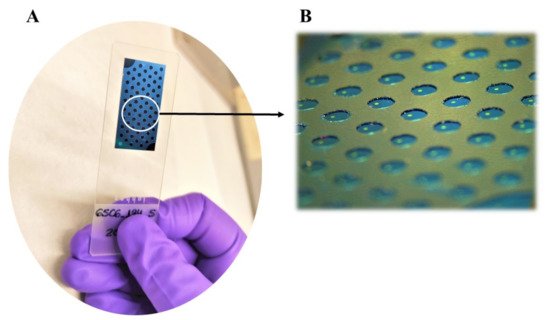
Figure 1.
(A) Multiplexed 65-well KIT used for the described assays. (B) Detail of the sensor used, highlighting the BICELLs in yellow surrounded by the PVC. Abbreviations: Biophotonic Sensing Cell (BICELL), Polyvinyl Chloride (PVC).
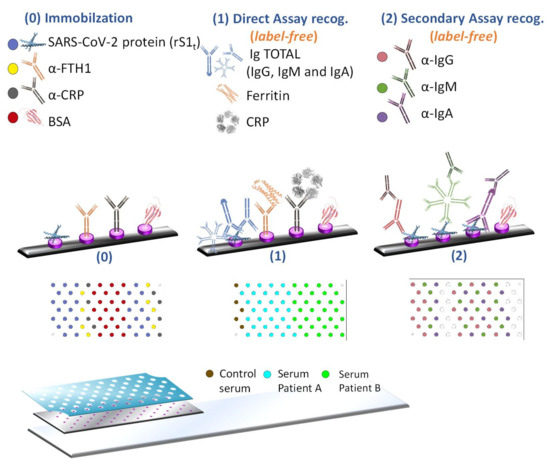
Figure 2.
Depiction of the methodology followed for SARS-CoV-2 detection. The diagnostic kit used for the multiplexed diagnosis (on the bottom of the figure) is composed of 65 biosensing sites (purple dots represented in the picture) made of SU-8 epoxy resist and fabricated on a Silicon substrate chip placed on a glass slide to facilitate its handling. The upper layer is a PVC container (a blue sheet on the image), which holds/separates the micro-volume samples. To carry out the assay, as a first step (0), the immobilization of specific bioreceptors is performed. Later, in step (1), the direct recognition of SARS-CoV-2 specific biomarkers sIgTs, FER, and CRP is measured from three different types of serum samples (two samples from unknown patients, and a control serum). Finally, step (2) determines the biosensing signal of sIgG, sIgM, and sIgA through incubation with secondary antibodies. Abbreviations: Severe Acute Respiratory Syndrome Coronavirus 2 (SARS-CoV-2), Anti-Ferritin heavy chain (α-FTH1) and anti-C Reactive Protein (α-CRP), recombinant SARS-CoV-2 spike protein (rS1), Bovine Serum Albumin (BSA) and C Reactive Protein (CRP).
2.5. Biofunctionalization of the Multiplexed Diagnostic KITs
First, the surface of the biosensing sites was activated through an O2 plasma [21,29] process to immobilize the specific bioreceptors, rS1, α-FTH, and α-CRP, by covalent binding. The diagnostic kits were incubated with 300 ng of rS1 (1 μL at 300 μg/mL in PBS (pH 7.5)), 100 ng of α-FTH1 (1 μL at 100 μg/mL in PBS (pH 7.5)), and 100 ng of α-CRP (1 μL at 100 μg/mL in PBS (pH 7.5)) until saturation, using an automated liquid dispensing platform, BioDot AD1520TM. BSA was incubated as a negative control (1 μL at 50 μg/mL in PBS (pH 7.5)) to check the selectivity of the sensing system. After that, proteins were incubated in a humid environment at 37 °C for 3 h.
After the incubation time, the diagnostic KITs were washed with Milli-Q water and dried with particle filters and dry air. Then, the readout signal (ΔIROP (%)) of each sensing site was measured, and the values were confirmed to fit within our admissible limits of tolerance. To prevent non-specific binding on the remaining binding surface, all diagnostic KITs were blocked with casein hydrolysate 1× for 1 h under agitation.
The BioDot dispensing system is able to dispense accurately small volumes of reagent (on the order of 100 nanoliters), allowing excellent reproducibility in the biofunctionalization stage.
2.6. In Vitro Detection of IgT, IgG, IgM, IgA, FER, and CRP
First, the diagnostic kits were biofunctionalized with rS1 protein and α -FTH1 and α -CRP antibodies, in addition to BSA protein as a negative control, and then were blocked. After this process, SARS-CoV-2 specific antibodies, FER and CRP, were measured. Serum samples were diluted at 1:10 and incubated in order to measure sIgT, FER, and CRP directly in a single step (Figure 2). In this case, specific antibodies (IgG, IgM, and IgA) to the virus, ferritin, and PCR were measured in each KIT for two different patients (together with their negative controls), and the positive control (PCR-confirmed COVID-19 patient) was incubated in each diagnostic KIT. After the washing process, the FER, CRP, and sIgT levels of the patients were directly detected.
Titers of the specific antibodies were analyzed simultaneously. The concentrations of IgGs, IgMs, and IgAs were determined by secondary antibodies (α-IgG, α-IgM, and α-IgA) (Figure 2). The readout signal ΔIROP (%) was measured after each stage of incubation.
For each biomarker, we examined the difference in the patient signal corrected by the BSA signal in the corresponding diagnostic KIT to determine the specific signal we were measuring, since we eliminated the background signal produced by each patient’s serum. The signal obtained in a serum sample of a clinically tested healthy patient minus the BSA signal in the corresponding diagnostic KIT plus the standard uncertainty was established as a negative control [30]. As a positive control signal, we considered that resulting from the serum sample of a clinically diagnosed patient. Both signals were used to control the quality of the measurements during the trial.
As the sample signals were referenced to the BSA level, and 5 of a given serum sample signal is the difference between the signal in the corresponding biomarker (sIgT, sIgG, sIgM, sIgA, FER, and CRP), normalized to the BSA signal, this protocol ensures the comparability of the data collected for this trial.
2.7. Statistical Comparisons among the Severe, Moderate, and Mild Patients’ Groups
We analyzed whether the degree of severity (Severe, Moderate, and Mild groups, as classified by the hospital) was a significant factor for the variable response IgT (the total concertation of specific immunoglobulins against SARS-CoV-2). As a result, the ANalysis Of VAriance (ANOVA) showed that the degree of severity was significant for the variable response (IgT) with a p-value of 0.045. When we compared the IgT for each of the different groups of severity (Severe, Moderate, and Mild), we observed that the Severe group was different from the Moderate and Mild groups. The pairwise comparison showed that, indeed, Severe was different from Moderate and Mild, with p-values of 0.028 and 0.036 respectively. Therefore, in terms of IgT, the groups Moderate and Mild were different from the group of Severe patients. However, the Moderate and Mild groups did not present significant differences (p-value = 0.917) in terms of IgT.
2.8. Multiple Linear Regression Models
In this case, study we employed a Multiple Linear Regression Model (MLRM) to evaluate the titers of sIgG, sIgM, and sIgA FER and CRP, and how they were correlated with the sIgT.
The steps for obtaining this model were as follows: we firstly obtained the correlation matrix among all the quantitative variables (sIgT, sIgG, sIgM, sIgA, FER, and CRP). The correlation results are presented at the end of the document. Secondly, we obtained the simple regression models of sIgT against sIgG, sIgM, sIgA, FER, and CRP to test that the variables were significant (see Table 1). Finally, we evaluated all the variables in the Multiple Regression Model, noting that the variable CRP was not significant, with a p-value of 0.472, which was much higher than the considered statistical significance level of 0.05. Finally, we removed the CRP variable for the Multiple Regression Model obtaining a goodness of fit of 70.29% (Adjusted R-Squared).

Table 1.
p-values obtained for the model of the simple linear regression model. p-values lower than the statistically significant level of (α = 0.05) can be considered to be related to sIgT.
Finally, we considered the qualitative variable of Severe, Moderate, and Mild in the Multiple Regression Model, allowing us to achieve a goodness of fit of 73.01% (Adjusted R-Squared). All the models presented a good statistical diagnosis.
3. Results
Four different proteins were immobilized as bioreceptors onto each interferometric biosensing site of the diagnostic KIT: α-FTH1, α-CRP, rS1, and BSA. In a first step, the patients’ samples were incubated, washed, dried, and optically readout to recognize FER, CRP, and sIgT, which mainly correspond to the compendium of sIgG, sIgM, sIgA against SARS-CoV-2. In a second step, we identified and classified the different types of antibodies incubating anti-human IgG (α-IgG), anti-human IgM (α-IgM), and anti-human IgA (α-IgA).
We measured the serum samples and analyzed the different biomarkers for each Level of Severity of COVID-19 (LSC) following the above-mentioned biosensing strategy. These results can be observed in serum samples from patients classified as severe (Figure 3), moderate (Figure 4), and mild (Figure 5). The level of the readout signal for the titer of sIgT, FER, and CRP is proportional to the concentration of those molecules in the sample [26,27]. However, the signal of the titers of sIgG, sIgM, and sIgA is proportional to the concentration of the secondary antibody employed to specifically recognize the human sIgG, sIgM, and sIgA present in the serum samples.
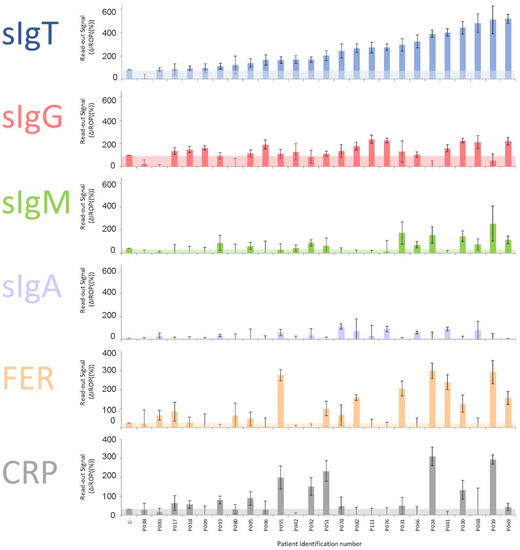
Figure 3.
Results of the biomarkers measured in samples from patients with Severe symptoms. The cut-off for each marker is shown in colored shading. Abbreviations: total specific Immunoglobulins (sIgT), specific Immunoglobulins G (sIgG), specific Immunoglobulins M (sIgM), specific Immunoglobulins A (sIgA), together with Ferritin (FER), Reactive Protein (CRP) and ΔIROP (%) (Increased Relative Optical Power.
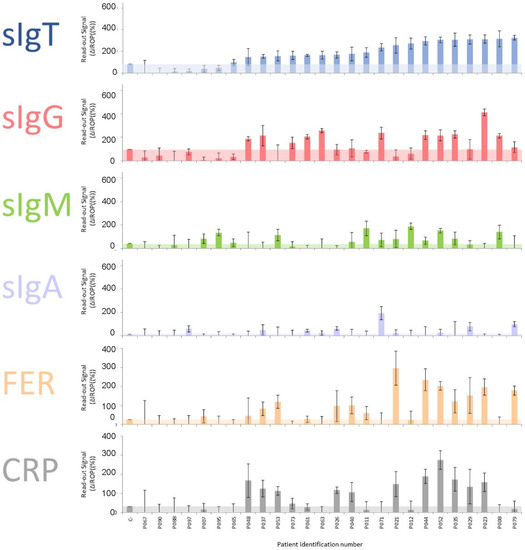
Figure 4.
Results of the biomarkers measured in samples from patients with Moderate symptoms. The cut-off for each marker is shown in colored shading. Abbreviations: total specific Immunoglobulins (sIgT), specific Immunoglobulins G (sIgG), specific Immunoglobulins M (sIgM), specific Immunoglobulins A (sIgA), together with Ferritin (FER), C Reactive Protein (CRP) and ΔIROP (%) (Increased Relative Optical Power.
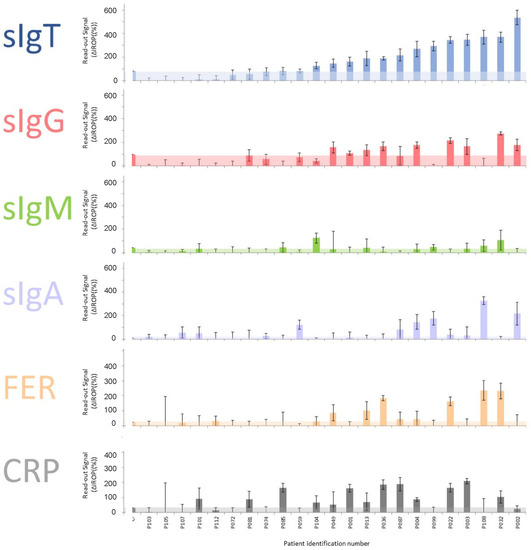
Figure 5.
Results of the biomarkers measured in samples from patients with Mild symptoms. The cut-off for each marker is shown in colored shading. Abbreviations: total specific Immunoglobulins (sIgT), specific Immunoglobulins G (sIgG), specific Immunoglobulins M (sIgM), specific Immunoglobulins A (sIgA), together with Ferritin (FER), Reactive Protein (CRP) and ΔIROP (%) (Increased Relative Optical Power.
To compare these results, we calculated the percentage of positives, considering the six biomarkers for each LSC. The results can be observed in Figure 6.
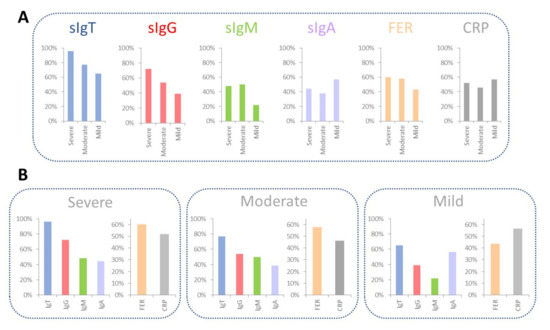
Figure 6.
Summary of the qualitative comparison. (A) Percentage of positives for each biomarker as a function of the LSC. (B) Classification of each LSC as a function of the titers of sIgT, sIgG, sIgM, sIgA, FER, and CRP. Abbreviations: Level of Severity of COVID-19 (LSC), total specific Immunoglobulins (sIgT), specific Immunoglobulins G (sIgG), specific Immunoglobulins M (sIgM), specific Immunoglobulins A (sIgA), together with Ferritin (FER), C Reactive Protein (CRP) and ΔIROP (%) (Increased Relative Optical Power.
We observed that 96% of Severe donors showed a positive sIgT signal, in contrast to 77% of Moderate and 65% of Mild patients.
Over 72% of Severe donors showed a positive sIgG signal, in contrast to over 54% of Moderate and 39% of Mild patients. Over 48% of Severe donors showed a positive sIgM signal, higher than in Moderate and Mild patients. Only 44% of Severe donors showed a positive sIgA signal, in contrast to 38 and 57% of Moderate and Mild patients, respectively.
Regarding the inflammatory biomarkers, over 60% of Severe patients showed significantly positive FER values in contrast to 58% of Moderate and 43% of Mild patients. There was not a trend in CRP positive values of Severe, Moderate, and Mild donors.
From a qualitative point of view, we observed that the positivity of the selected biomarkers depends on the severity of COVID-19, leading to a higher titer of antibodies, particularly for sIgT and sIgG for Severe patients, in contrast to the titer of sIgA. It is also observed that the percentage of positives in FER is higher for Severe patients, and no differences were found in the percentage of CRP.
We considered it worthy to analyze some asymptomatic cases. Twenty blood donors from the hospital Clínico San Carlos were analyzed in order to obtain a preliminary figure of potential asymptomatic cases. As a result, we included some cases at the end of February 2020, and we also measured some volunteers from our research center at the end of May 2020.
We discovered that some blood donors presented a significant titer of specific antibodies to SARS-CoV-2 (Figure 7), and although the sample of 20 donors was limited, the roughly five cases found to represent a percentage of 25%.
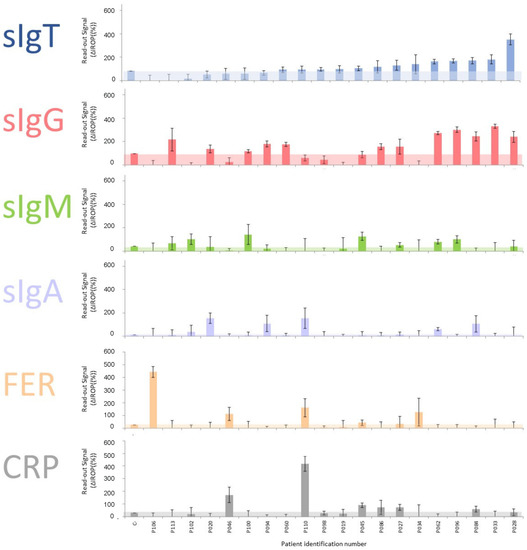
Figure 7.
Asymptomatic cases of blood donors at the end of February 2020. Abbreviations: total specific Immunoglobulins (sIgT), specific Immunoglobulins G (sIgG), specific Immunoglobulins M (sIgM), specific Immunoglobulins A (sIgA), together with Ferritin (FER), C Reactive Protein (CRP) and ΔIROP (%) (Increased Relative Optical Power.
Finally, we studied these experimental results by analyzing the degree of correlation of each biomarker measured (sIgG, sIgM, sIgA, FER, and CRP) in the diagnostic KIT.
In this basic model, we observed that sIgG, sIgM, and FER were rather more significant than sIgAs and CRP. It could be assumed that sIgAs do not provide much more additional information once IgGs and IgMs have been analyzed, and CRP behaves as an unspecific biomarker for COVID-19. In Figure 8, this correlation matrix can be observed:
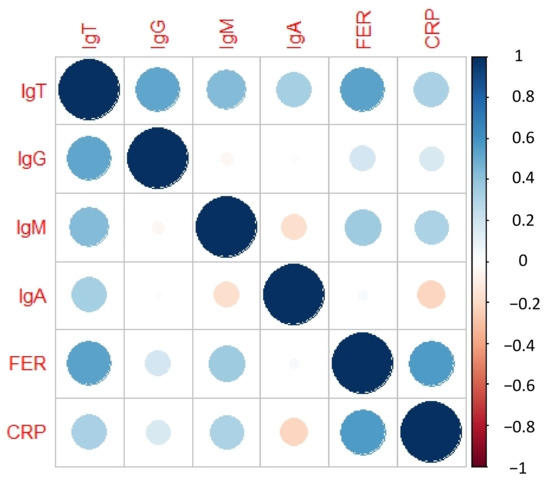
Figure 8.
Correlation matrix. The size of the circles shows the correlation level highlighted on the left bar of the figure. Abbreviations: total specific Immunoglobulins (sIgT), specific Immunoglobulins G (sIgG), specific Immunoglobulins M (sIgM), specific Immunoglobulins A (sIgA), together with Ferritin (FER) and C Reactive Protein (CRP).
The p-values for each biomarker are presented in Table 1.
Once the individual correlation of each of the individual biomarkers with the total amount of specific antibodies against SARS-CoV-2 had been analyzed, we analyzed a multiple regression model correlating the sIgT with the biomarkers sIgG, sIgM, sIgA, FER, and CRP. In this model, we observed that CRP was not a significant variable, confirming that CRP is an unspecific biomarker due to its expression in multiple inflammatory pathologies [31]. In fact, the p-value of CRP in this model of 0.47 is much higher than the statistically significant level considered of 0.05. Thus, avoiding the CRP in the multiple regression model, we observed that sIgG (p-value = 1.5 × 10−10), sIgM (p-value = 6.08 × 10−8), sIgA (p-value = 7.09 × 10−8) and FER (p-value = 1.7 × 10−4) were highly significant. Considering this final model, we calculated the coefficients to explain the sIgT as a function of the abovementioned biomarkers sIgG, sIgM, sIgA, and FER obtaining the model in Equation (1):
It can be observed that the higher the concentration of IgG, IgM, IgA, and FER, the higher the concentration of sIgT. In this case, the goodness of fit found was 70.29% (Adjusted R-Squared). This means that the total level of specific immunoglobulins against SARS-CoV-2 increases with increasing levels of sIgGs, sIgMs, and sIgGs, and FER is a specific biomarker for COVID-19.
Finally, given that we have classified the severity of COVID-19, (Severe, Moderate, and Mild) we considered studying these qualitative variables in the multiple regression model. This model can be observed in Equation (2), which in this case, explains the total amount of specific immunoglobulins against SARS-CoV-2 with a goodness of fit of 73.01% (Adjusted R-Squared).
In this model, Severe patients corresponded with the intercept, which had a coefficient of 22.72. It was clearly observed that the higher the sIgG, sIgM, sIgA, and FER, the higher the level of IgT. Moreover, it is worthy to note that Mild and Moderate patients exhibited decreased levels of sIgT, which is quite sensible, and this result could suggest that the severity of COVD19 is related to the total amount of sIgTs and FER.
4. Discussion
In this work, we report the benefits of using this type of in vitro diagnostic system, which consists of a highly multiplexing diagnostic KIT based on IODM and ΔIROP (%) measurement to evaluate the COVID-19 disease, considering multiple biomarkers by a rapid, cost-effective, affordable, and reliable method. In addition, its handling is perfectly compatible with the usual practice in clinical analysis laboratories.
For this particular study, we considered six biomarkers: sIgT, the aforementioned specific SARS-CoV-2 antibodies, and two inflammatory biomarkers. Regarding the qualitative analyses in serum, a higher level of sIgT was observed in Severe patients compared to Moderate and Mild patients. This was the case, as well, for the biomarkers sIgG and sIgM. We also found differences in the inflammation marker FER, which was higher in patients. However, no significant differences were found for the other marker CRP. It is relevant to stress that at the end of February 2020, over 25% of blood donors at Hospital Clínico San Carlos showed previous contact with SARS-CoV-2.
We evaluated the biomarkers considered and built a multiple regression model to analyze the influence of these biomarkers on COVID-19. As a result, it is worth mentioning that this model explained the influence of the sIgG, sIgM, sIgA, and FER in the observation of sIgT with a goodness of fit of 73.01% (Adjusted R-Squared).
It must be considered that the sIgGs, sIgMs, and sIgAs biomarkers were obtained in a second incubation step with a secondary antibody, in contrast with sIgT, which was obtained directly due to the change in the interferometry pattern (label-free detection) after the first incubation step. Therefore, it is logical that there was no direct correction. However, even considering that the detection mechanism was different, it is remarkable that the results obtained are highly consistent, and it can be observed that the higher the sIgGs, sIgMs, and sIgAs, the higher the level of sIgT. It is also relevant to consider how the FER biomarker behaves as a specific biomarker for COVID-19, in contrast with the unspecific CRP biomarker in the multiple regression model obtained. Finally, we must emphasize that when the severity of the disease was included in the multiple regression model, the patients with higher levels of specific immunoglobulins against SARS-CoV-2 corresponded to the Severe patients, suggesting that the severity of COVD19 is related to the total amounts of sIgTs and FER.
Finally, in this work, we report a case study for measuring six biomarkers exhibiting relevant results and demonstrating the capacity for this technology to be transferred and used in clinical practice. It is also worth mentioning here that this technology can be easily designed to measure multiple biomarkers in order to improve the screening capacity in the future. With the ability to simultaneously measure many biomarkers, for example, this KIT can be designed for other relevant biomarkers as prognostic factors of the disease, such as some cytokines, in a single patient sample, while at the same time justifying and validating the benefits of using highly multiplexed KITs to predict disease and to investigate which are the most appropriate biomarkers, speeding up the screening capacity in an affordable way.
Author Contributions
Envisioned and designed the experiments, M.H. and E.U.; collected and processed the samples and performed the experimental assays, A.M.M.M., L.G.V., Y.R., M.F.L. and R.L.E.; samples collection from hospitalized COVID-19 patients and the access to patient information through the Biobank of Hospital Clínico San Carlos, E.M.-R. and I.O.-M.; development of diagnostic kits, L.T., P.H. and B.S.; developed and produced the SARS-CoV-2 (rS1) protein, A.D.-P., M.G.-A., J.T.-A., G.H.-R. and M.H.; analysis of qualitative results, A.D-P.; analysis of quantitative results, M.H. and M.J.S. All authors have read and agreed to the published version of the manuscript.
Funding
This work was supported by the Research and Innovation program of Universidad Politécnica de Madrid (https://www.upm.es/Investigacion/Programa_Propio_UPM) under the project with reference: VIMPACTO20MHB, the project HERON with reference TEC2017-84846-R supported by the Spanish Ministry of economy and competitiveness, and within the framework of the project COVIDTECH-CM of the regional government of Madrid (Spain).
Institutional Review Board Statement
The study was conducted in accordance with the Declaration of Helsinki, and approved by the or Ethics Committee of Hospital Clínico San Carlos (B.0000725; PT17/0015/0040; ISCIII-FEDER; 14 April 2020).
Informed Consent Statement
Informed consent was obtained from all subjects involved in the study.
Data Availability Statement
Not applicable.
Acknowledgments
The authors also acknowledge Luis Enjuanes and Isabel Sola from the Coronavirus laboratory, Centro Nacional de Biotecnología belonging to the Spanish Research Council (CNB-CSIC), who provided the DNA of the SARS-CoV-2 S gene used to express the recombinant protein included in the detection system; the Biobank of the Hospital Clínico San Carlos-IdISSC for the patients’ samples; and Bio Optical Detection for the support on the readout platform. Mass spectrometry analysis was performed at the Centro de Apoyo a la Investigación (CAI) de Espectrometría de Masas of Universidad Complutense de Madrid. We wish also to thank the Unidad de Innovación (UI); Unidad de Investigación Clínica y Ensayos Clínicos (UICEC); Unidad de Apoyo Metodológico a la Investigación (UAMI); Biobanco; Unidad de Apoyo a los Comités de Ética (UACE; Unidad de Apoyo a Farmacia: gestión de medicación de investigación (UFAR); and Laboratorios Gabinetes y Servicios Clínicos de Apoyo a la Investigación (LABSERCLI) for their most valuable efort. Investigators of IdISSC-COVID-TASKFORCE and COVID-19_ URG-HCSC Register: Carlos Javier Llamas, Laura Matilla, Ma Luisa Bretón, Beatriz Rojano, José Antonio Bustamante, Eric Jorge García Lamberechts, Manuel Maroto, Álvaro Martin Ruiz, María Martínez Agüero, Arturo Corbatón, Cesario Fernández Alonso, Jaime Abelaira, Pablo Matías, Raúl Perales, María Rosario Blázquez, M. Carmen Muñoz, Alejandra Ortega, Carlota Clemente, Sara Laínez, Antonio Trino Salto Ariza, Pedro Villarroel González Elipe, Juan Manuel Algarra, Javier Candel, Encarnación Fernández del Palacio, Rosa Moreno Rodríguez, Daniel Muñoz Jiménez, Vicente Estrada, María Jesús Téllez, Ángel Molino, María José Núñez, Noemí Cabello, Nieves Martel, Myriam Calle, Miguel Holgado, María Luaces, Germán Seara, Joan Cháfer, Ángel Luis del Rey, Mercedes Martínez-Novillo, Alberto Delgado-Iribarren, Ma Ángeles Cuadrado Cenzual, María José Torrejón Martínez, Fernando Ataúlfo González Fernández, Silvia Sánchez Ramón, Asunción Mora, Ana Arribi Vilella, Miguel Fernández Armero, José Manuel Martínez Sesmero, Rocío Manzano, Virginia Puebla, Juan Arrazola, Ana Bustos, Laura Galván, Ana Mañas, Ángel Nava Muñoz, Sara Gómez Peña, Beatriz Cabeza Martínez, Irene Martín López, Joaquín López Herraiz, Alfonso Calle, Miguel Ángel Rubio Herrera, Isabel Runckle, Eduardo Anguita Mandley, Blanca García Reneses, David Fraguas, Marina Díaz Marsa, José Luis Carrasco, Julia Sevilla, Iabel Ramos, Marta Navas, Aránzazu Álvarez de Arcaya, José Ramón Núñez, Mar García Arenillas, Lourdes Cabrera, Carlos Macaya, Fernando Macaya, Iván Nuñez-Gil, Jorge Matías-Guiu, Jesús Porta, Miguel Sánchez, Fernando Martínez Sagasti, Leonor Laredo, Emilio Vargas, Alberto Mariano Lázaro, Carmende Burgos, Manuel Fuentes Ferrer, Gloria Mato Chian, Beatriz Peláez Ros, María Ángeles Valcárcel de la Iglesia, Nayade del Prado, José Ma Leal Pozuelo, José Luis Fernández Rueda, Víctor Hernández Martín-Romo, Elena Urcelay, Antonio Portolés, and Julio Mayol.
Conflicts of Interest
The authors declare no conflict of interest.
References
- Yan, R.; Zhang, Y.; Li, Y.; Xia, L.; Guo, Y.; Zhou, Q. Structural Basis for the Recognition of SARS-CoV-2 by Full-Length Human ACE2. Science 2020, 367, 1444–1448. [Google Scholar] [CrossRef]
- Xu, X.; Sun, J.; Nie, S.; Li, H.; Kong, Y.; Liang, M.; Hou, J.; Huang, X.; Li, D.; Ma, T.; et al. Seroprevalence of Immunoglobulin M and G Antibodies against SARS-CoV-2 in China. Nat. Med. 2020, 26, 1193–1195. [Google Scholar] [CrossRef]
- Liu, T.; Hsiung, J.; Zhao, S.; Kost, J.; Sreedhar, D.; Hanson, C.V.; Olson, K.; Keare, D.; Chang, S.T.; Bliden, K.P.; et al. Quantification of Antibody Avidities and Accurate Detection of SARS-CoV-2 Antibodies in Serum and Saliva on Plasmonic Substrates. Nat. Biomed. Eng. 2020, 4, 1188–1196. [Google Scholar] [CrossRef]
- Huang, Y.; Yang, C.; Xu, X.; Xu, W.; Liu, S. wen Structural and Functional Properties of SARS-CoV-2 Spike Protein: Potential Antivirus Drug Development for COVID-19. Acta Pharmacol. Sin. 2020, 41, 1141–1149. [Google Scholar] [CrossRef]
- Petherick, A. Developing Antibody Tests for SARS-CoV-2. Lancet 2020, 395, 1101–1102. [Google Scholar] [CrossRef]
- Wang, J.; Chen, C.; Li, Q.; Cai, P.; Wang, Z.; Wang, L. COVID-19 confirmed patients with negative antibodies results. BMC Infect. Dis. 2020, 20, 698. [Google Scholar] [CrossRef] [PubMed]
- European Centre for Disease Prevention and Control. Immune Responses and Immunity to SARS-CoV-2. COVID19 Latest Evidence; European Centre for Disease Prevention and Control: Brussels, Belgium, 2020. [Google Scholar]
- Weisberg, S.P.; Connors, T.J.; Zhu, Y.; Baldwin, M.R.; Lin, W.-H.; Wontakal, S.; Szabo, P.A.; Wells, S.B.; Dogra, P.; Gray, J.; et al. Distinct Antibody Responses to SARS-CoV-2 in Children and Adults across the COVID-19 Clinical Spectrum. Nat. Immunol. 2020, 2020, 1–7. [Google Scholar] [CrossRef] [PubMed]
- Pierce, C.A.; Preston-Hurlburt, P.; Dai, Y.; Aschner, C.B.; Cheshenko, N.; Galen, B.; Garforth, S.J.; Herrera, N.G.; Jangra, R.K.; Morano, N.C.; et al. Immune Responses to SARS-CoV-2 Infection in Hospitalized Pediatric and Adult Patients. Sci. Transl. Med. 2020, 12, 5487. [Google Scholar] [CrossRef]
- Götzinger, F.; Santiago-García, B.; Noguera-Julián, A.; Lanaspa, M.; Lancella, L.; Calò Carducci, F.I.; Gabrovska, N.; Velizarova, S.; Prunk, P.; Osterman, V.; et al. COVID-19 in Children and Adolescents in Europe: A Multinational, Multicentre Cohort Study. Lancet Child Adolesc. Health 2020, 4, 653–661. [Google Scholar] [CrossRef]
- Borobia, A.; Carcas, A.; Arnalich, F.; Álvarez-Sala, R.; Monserrat-Villatoro, J.; Quintana, M.; Figueira, J.; Torres Santos-Olmo, R.; García-Rodríguez, J.; Martín-Vega, A.; et al. A Cohort of Patients with COVID-19 in a Major Teaching Hospital in Europe. J. Clin. Med. 2020, 9, 1733. [Google Scholar] [CrossRef]
- Amanat, F.; Stadlbauer, D.; Strohmeier, S.; Nguyen, T.H.O.; Chromikova, V.; McMahon, M.; Jiang, K.; Arunkumar, G.A.; Jurczyszak, D.; Polanco, J.; et al. A Serological Assay to Detect SARS-CoV-2 Seroconversion in Humans. Nat. Med. 2020, 26, 1033–1036. [Google Scholar] [CrossRef]
- Tré-Hardy, M.; Wilmet, A.; Beukinga, I.; Dogné, J.-M.; Douxfils, J.; Blairon, L. Validation of a Chemiluminescent Assay for Specific SARS-CoV-2 Antibody. Clin. Chem. Lab. Med. 2020, 58, 1357–1364. [Google Scholar] [CrossRef]
- Zhang, C.; Wu, Z.; Li, J.W.; Zhao, H.; Wang, G.Q. Cytokine Release Syndrome in Severe COVID-19: Interleukin-6 Receptor Antagonist Tocilizumab May Be the Key to Reduce Mortality. Int. J. Antimicrob. Agents 2020, 55, 105954. [Google Scholar] [CrossRef]
- Wu, D.; Yang, X.O. TH17 Responses in Cytokine Storm of COVID-19: An Emerging Target of JAK2 Inhibitor Fedratinib. J. Microbiol. Immunol. Infect. 2020, 53, 368–370. [Google Scholar] [CrossRef]
- Mehta, P.; McAuley, D.F.; Brown, M.; Sanchez, E.; Tattersall, R.S.; Manson, J.J. COVID-19: Consider Cytokine Storm Syndromes and Immunosuppression. Lancet 2020, 395, 1033–1034. [Google Scholar] [CrossRef]
- Panahi, A.; Sadighbayan, D.; Forouhi, S.; Ghafar-Zadeh, E. Recent Advances of Field-Effect Transistor Technology for Infectious Diseases. Biosensors 2021, 11, 103. [Google Scholar] [CrossRef]
- Yakoh, A.; Pimpitak, U.; Rengpipat, S.; Hirankarn, N. Paper-Based Electrochemical Biosensor for Diagnosing COVID-19: Detection of SARS-CoV-2 Antibodies and Antigen. Biosens. Bioelectron. 2020, 176, 112912. [Google Scholar] [CrossRef]
- Nascimento, E.D.; Fonseca, W.T.; De Oliveira, T.R.; de Correia, C.R.; FaÇa, V.M.; de Morais, B.P.; Silvestrini, V.C.; Pott-Junior, H.; Teixeira, F.R.; Faria, R.C. COVID-19 Diagnosis by SARS-CoV-2 Spike Protein Detection in Saliva Using an Ultrasensitive Magneto-Assay Based on Disposable Electrochemical Sensor. Sens. Actuators B Chem. 2020, 353, 131128. [Google Scholar] [CrossRef]
- Akib, T.B.A.; Mou, S.F.; Rahman, M.M.; Rana, M.M.; Islam, M.R.; Mehedi, I.M.; Parvez Mahmud, M.A.; Kouzani, A.Z. Design and Numerical Analysis of a Graphene-Coated Spr Biosensor for Rapid Detection of the Novel Coronavirus. Sensors 2021, 21, 3491. [Google Scholar] [CrossRef]
- Murillo, A.M.M.; Tomé-Amat, J.; Ramírez, Y.; Garrido-Arandia, M.; Valle, L.G.; Hernández-Ramírez, G.; Tramarin, L.; Herreros, P.; Santamaría, B.; Díaz-Perales, A.; et al. Developing an Optical Interferometric Detection Method Based Biosensor for Detecting Specific SARS-CoV-2 Immunoglobulins in Serum and Saliva, and Their Corresponding ELISA Correlation. Sens. Actuators B Chem. 2021, 345, 130394. [Google Scholar] [CrossRef] [PubMed]
- Laguna, M.; Ramirez, Y.; Fernandez Martinez, C.; Espinosa, R.L.; Lavín, A.; Holgado, M. A Point-of-Care Based on Label-Free Interferometric Optical Detection Method to Evaluate Interferon Gamma (IFN-γ): A Correlation with the ELISA Technique. Sensors 2020, 20, 4776. [Google Scholar]
- Holgado, M.; Sanza, F.; López, A.; Lavín, Á.; Casquel, R.; Laguna, M. Description of an Advantageous Optical Label-Free Biosensing Interferometric Read-Out Method to Measure Biological Species. Sensors 2014, 14, 3675–3689. [Google Scholar] [CrossRef] [PubMed]
- Lavín, Á.; Casquel, R.; Sanza, F.J.; Laguna, M.F.; Holgado, M. Efficient Design and Optimization of Bio-Photonic Sensing Cells (BICELLs) for Label Free Biosensing. Sens. Actuators B Chem. 2013, 176, 753–760. [Google Scholar] [CrossRef]
- Sanza, F.J.; Holgado, M.; Ortega, F.J.; Casquel, R.; López-Romero, D.; Bañuls, M.J.; Laguna, M.F.; Barrios, C.A.; Puchades, R.; Maquieira, A. Bio-Photonic Sensing Cells over Transparent Substrates for Anti-Gestrinone Antibodies Biosensing. Biosens. Bioelectron. 2011, 26, 4842–4847. [Google Scholar] [CrossRef]
- Holgado, M.; Maigler, M.V.; Santamaría, B.; Hernandez, A.L.; Lavín, A.; Laguna, M.F.; Sanza, F.J.; Granados, D.; Casquel, R.; Portilla, J.; et al. Towards Reliable Optical Label-Free Point-of-Care (PoC) Biosensing Devices. Sens. Actuators B Chem. 2016, 236, 765–772. [Google Scholar] [CrossRef]
- Maigler, M.V.; Holgado, M.; Laguna, M.F.; Sanza, F.J.; Santamaria, B.; Lavin, A.; Espinosa, R.L. A New Device Based on Interferometric Optical Detection Method for Label-Free Screening of C-Reactive Protein. IEEE Trans. Instrum. Meas. 2018, 68, 3193–3199. [Google Scholar] [CrossRef]
- Diaz-Perales, A.; Garcia-Casado, G.; Sanchez-Monge, R.; Garcia-Selles, F.J.; Barber, D.; Salcedo, G. CDNA Cloning and Heterologous Expression of the Major Allergens from Peach and Apple Belonging to the Lipid-Transfer Protein Family. Clin. Exp. Allergy 2002, 32, 87–92. [Google Scholar] [CrossRef]
- Grimaldi, I.A.; Testa, G.; Persichetti, G.; Loffredo, F.; Villani, F.; Bernini, R. Plasma Functionalization Procedure for Antibody Immobilization for SU-8 Based Sensor. Biosens. Bioelectron. 2016, 86, 827–833. [Google Scholar] [CrossRef]
- Lavín, Á.; de Vicente, J.; Holgado, M.; Laguna, M.F.; Casquel, R.; Santamaría, B.; Maigler, M.V.; Hernández, A.L.; Ramírez, Y. On the Determination of Uncertainty and Limit of Detection in Label-Free Biosensors. Sensors 2018, 18, 2038. [Google Scholar] [CrossRef]
- Sproston, N.R.; Ashworth, J.J. Role of C-Reactive Protein at Sites of Inflammation and Infection. Front. Immunol. 2018, 9, 754. [Google Scholar] [CrossRef]
Publisher’s Note: MDPI stays neutral with regard to jurisdictional claims in published maps and institutional affiliations. |
© 2022 by the authors. Licensee MDPI, Basel, Switzerland. This article is an open access article distributed under the terms and conditions of the Creative Commons Attribution (CC BY) license (https://creativecommons.org/licenses/by/4.0/).